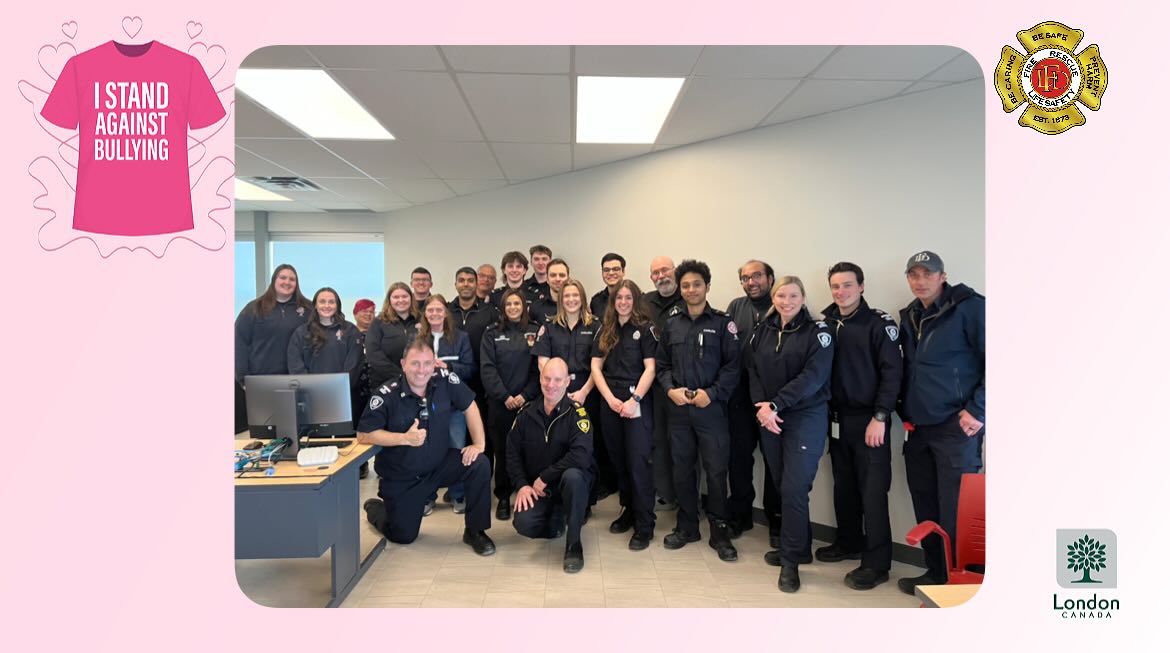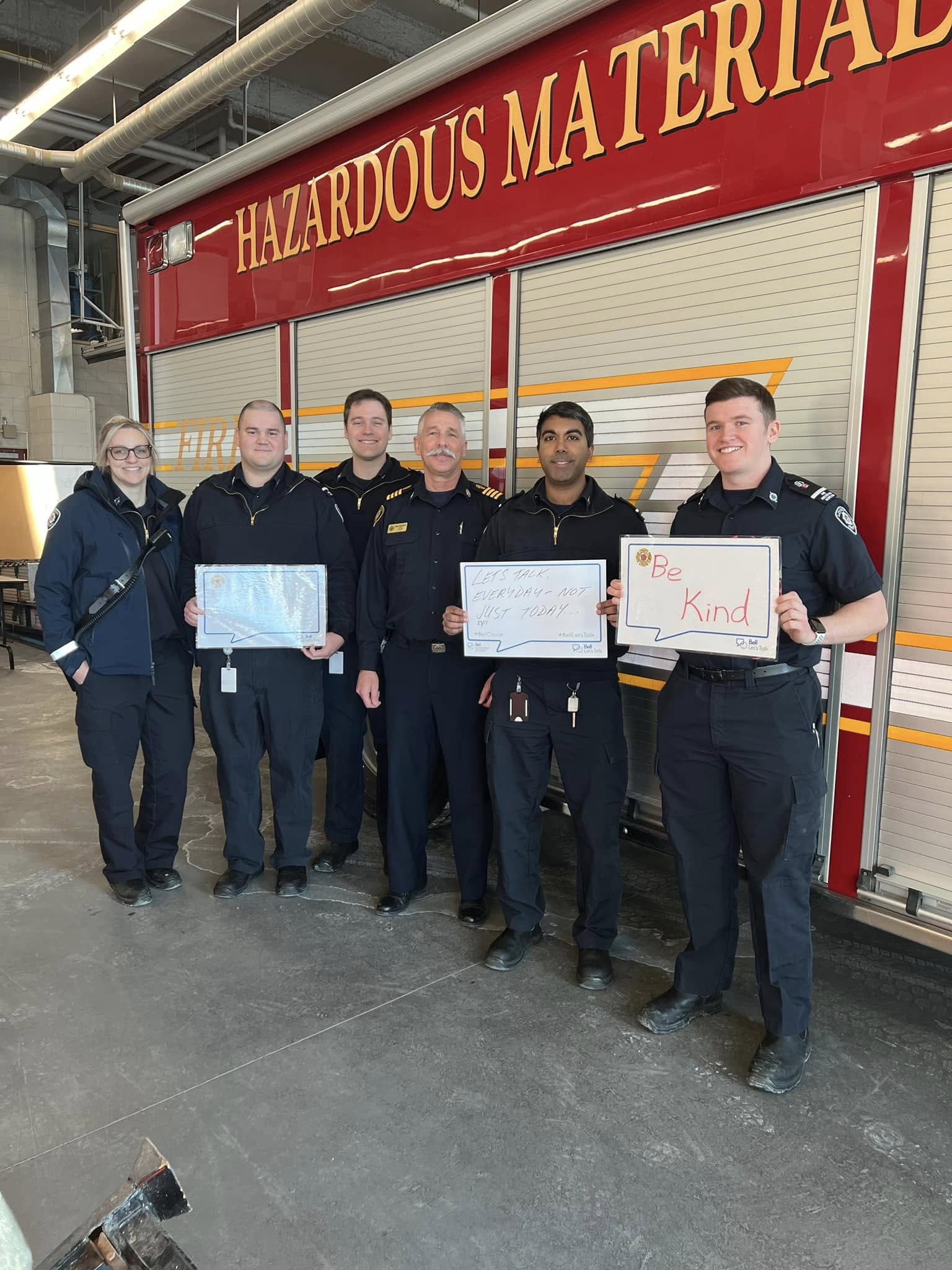
Deputy Fire Chief (Retired) Peter Harding in front of
Fire Hall No. 4 on Colborne St. where he spent
the early part of one of his careers.
(Craig Gilbert / London Community News)
In the Spotlight: The three careers of W. Peter Harding
For a man who began a lifetime in public service before the Order of Canada was even established, retirement will always be a relative term.
Walter Peter H. Harding retired from the London Fire Department (LFD) as a deputy chief on April 30, 1998 after 38 years of service, but that date was far from the end of his time helping those in dire straits.
Harding actually spent more time with St. John Ambulance than he did at the LFD, retiring from that organization in 2007 after 40 years of service, the last 18 as superintendent for London-Middlesex County.
A charter (founding) member of the London and Area Food Bank, the 75-year-old is currently the chair of its executive board, a former Deputy Grand Knight of Knights of Columbus branch #13404 (St. Peter’s Basilica) and first vice-president of the Irish Benevolent Society’s London chapter for 2013-14.
That may sound like a lot of hats, but Harding feels somewhat like he’s been wearing the same uniform the entire time. He credits his work ethic and passion for helping others from the values his parents instilled in him.
“The fire department, St. John, the food bank, it all stemmed from that sense of service,” he said. “The departments were good to me and I was able to use that for the citizens and the community as a whole, not only the job. What I’ve been doing is try to give back to the community. In all the various careers I’ve been very, very fortunate so if I can give back I try to do that.”
It all started in 1955, the summer after Harding’s Grade 11 year. He was working as a summer student for the railway mail service, sorting mail on passenger trains travelling though southwestern Ontario when he saw a want ad for London’s first-ever professional emergency medical service, Ballantyne Ambulance.
Harding had no medical training and couldn’t even drive the sparsely equipped ambulance because he didn’t have a chauffer’s licence, but they took him on faith.
There were no paramedic courses at colleges back then, but many former military medics were hired in those days so Harding’s training took place on the job.
“The only training that was around was St. John Ambulance training,” Harding said. “I learned on the street. In those days all you had in the vehicle was an oxygen tank and mask, a stretcher, a set of splits and field dressings.”
On May 16, 1960, he was hired as a fourth-class firefighter with the London Fire Department (LFD), which at the time was looking for men with experience in the medical field. By then, Harding had several years experience with a variety of ambulance services in London, and even worked as an operating room technician at St. Joseph’s Hospital, across the road from the Grovesnor Street home where he grew up and eventually returned to raise his own family.
There were about 120 firefighters in the department in 1960, compared to more than 350 firefighters and civilian employees today.
“They had a rescue unit that responded to everything,” he said. “Medical calls, rescues, heavy rescues, just about anytime anyone had a problem, rescue would respond.”
Harding spent a decade in heavy rescue but he didn’t start there. Like any apprenticeship, Harding had to earn his stripes.
“You had to spend four years learning the trade before you were assigned to a trade within the system,” he recalled. “Way back when, when you served your apprenticeship from fifth class to fourth, to first, in second or first you take up specific trade and mine was heavy rescue.”
Harding’s CV reads like a historical account of the major emergencies Ontario has experienced in the past half-century, including the Mississauga evacuation in 1979, the largest peacetime evacuation in North America until the flooding of New Orleans in 2005.
He was also involved in the response to derailments in Hyde Park, Komoka, Pickering, Melbourne, Kerwood, Newbury and Chatham, tornadoes in Reeces Corners (1983) and Barrie (1985) and the Quebec ice storm as part of London’s St. John brigade unit, the first established in Canada back in 1909.
“I can probably say almost 50 major emergencies within Ontario we were assigned to, from Cobourg straight through to Windsor (and) I can recall offhand eight major derailments between Chatham and Toronto. It was a unit that everybody took pride in and did a great job.”
For the Hardings, volunteering with St. John was a family affair. His wife, Janet and four children, Shaune, Janet, Peter and Paul have all served as St. John officers.
His wife was a registered nurse, as are Shaune and Janet. Paul is a retired paramedic (whose wife, a doctor, was also in St. John in London) living in British Columbia and Peter is a computer expert working in Chicago.
Harding said that volunteer spirit, for whatever reason, seems to be waning in society today.
“(Police, fire and ambulance) have relied on St. John but I think now even St. John hasn’t got the service, one or two units,” he said. “In fact, if I can remember, 2013 was the first year in a hundred years St. John was not at the (Western) Fair. I couldn’t believe it. So what happens when you don’t use organizations like that and keep them functioning? It’ll hurt us one day.”
Harding was admitted to the Order of St. John in 1976, which until the Order of Canada was established in 1967 was the only means of recognizing chivalry from members of the civilian population.
Like the Order of Canada, there are tiers recognizing increasing levels of meritorious service within the Order of St. John, and Harding advanced through them steadily until he was promoted to its second-highest grade, Knight of Justice, in 2003.
He has a litany of other honours and awards, including a Golden Jubilee Medal, the federal exemplary fire service medal and 25-year service medals (plus the 35-year bar) for firefighters and St. John Ambulance.
If there’s a medal attached to the honour Harding wears it on the “closetful of dress uniforms” he owns. There are so many medals on his chest that colleagues tease him for it, but he said it’s not about boasting.
“I wasn’t asking for it but people have picked it up and run with it,” he said. “It’s a bit embarrassing, but I’ll tell you one reason why I wear it and it’s for the guys that did the work (behind the scenes). There are a lot of people that make these things happen.”





